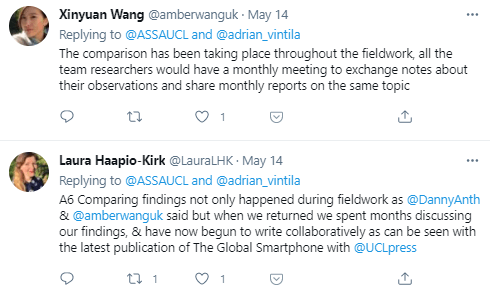2021 round-up and happy new year!
By Laura Haapio-Kirk, on 31 December 2021
By Danny Miller and Laura Haapio-Kirk
2021, despite its difficulties, has been a key year for the ASSA project. The high point for us was in May with the publication of the jointly-authored comparative book The Global Smartphone. The book presents a radically different understanding of what the smartphone is, based not on speculation but a huge amount of direct observation of its use and consequences around the world based on our 16-month ethnographies. The book is available to download for free from UCL Press, along with the two translations in Italian and Spanish that have already been published, and it is currently being translated into the other languages of our fieldsites (Japanese, Chinese, French, Portuguese). The publication launch was well covered in the media including full-page discussions in newspapers such as the Guardian and Sunday Times, international press ranging from the World Economic Forum to local publications around the world, and BBC radio interviews.
Also published were the first two of our monographs: Ageing with Smartphones in Ireland by Pauline Garvey and Daniel Miller, and Ageing with Smartphones in Urban Italy by Shireen Walton. We are on track for more of our ethnographies to published as monographs in 2022. Once they are all published we will have a total of nine monographs documenting the ways in which experiences of ageing and the use of the smartphone are now inextricably interwoven in various ways for people around the world. Watch this space!

Comic based on research by Alfonso Otaegui, scripted by Laura Haapio-Kirk and Georgiana Murariu, and illustrated by John Cei Douglas.
Our website, designed to complement the book series, features videos, infographics, comics, and stories from the fieldsites, presented in a way that is intended to be accessible and engaging. For example, we took several of our key findings that appear in The Global Smartphone and created a ‘Discoveries’ section of the site that allows for a multi-media introduction to the central ideas emerging from the research. The website recently won the AVA 2021 Award for Best Visual Ethnographic Material Addressing Ageing and the Life Course in the Multimodal category. The AVA Award is a collaborative effort of the EASA’s Age and Generations Network, Association for Gerontology, Aging and the Life Course and EASA’s Visual Anthropology Network.
We also launched our online course: An Anthropology of Smartphones: Communication, Ageing and Health on FutureLearn. We were very happy to meet many enthusiastic learners from around the world, and were delighted with their feedback on the course. The course features many videos and interactive elements that encourage participants to become ethnographers in their own right. We will announce future dates, so please do register here for updates if you would like to take part in the next round.

Feedback from FutureLearn learners on our course.
We are currently developing our mHealth agenda, including producing an edited book to be published by UCL Press, featuring chapters by the team about their various mHealth initiatives. We are also progressing applied projects around mental health and nutrition in Uganda and Trinidad respectively.
As you can see, it has been a busy year and we are delighted to be able to start sharing with you the results of our research.
We hope that you are keeping safe and well, and wish you a happy new year from the entire ASSA team!
 Close
Close





































